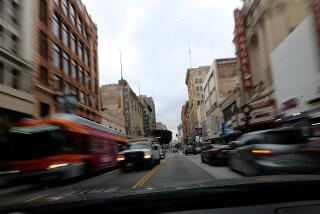Officials Urge Inquiry Into Tunnel Flaws : Red Line: Local authorities seek an independent investigation while staff and the contractor stress that the subway structures are safe and sound. The federal Transportation Department begins its own study.
An independent agency or expert--without ties to the staff or consultants of the county Metropolitan Transportation Authority--should examine why concrete tunnels in some areas of the new subway are thinner than designed, local officials said Monday.
Such an examination should assess the competency of inspections, contract oversight during construction and whether further repairs are necessary to ensure the safety of the tunnels linking Union Station with Pershing Square.
In Washington, a Department of Transportation spokesman said the agency will immediately order an outside firm to report preliminarily on the matter. That firm, Hill International, monitors how federal money is spent on the subway project.
Based on Hill International’s findings, department spokesman Brian Cudahy said, the agency will decide if further investigation is necessary. “We have to protect the interests of the American taxpayers,” he said.
Local transit staff responsible for overseeing construction of the subway, along with the contractor who built the tunnels, reiterated Monday that they believe the structures are safe and sound.
“We have nothing to hide and firmly stand behind the structural integrity of these Metro Rail tunnels,” said Edward McSpedon, president of the MTA’s Rail Construction Corp. “Did we get what we paid for? Yes. Were appropriate repairs (in areas of thin concrete) made? Yes.”
Ronald N. Tutor, whose company built the tunnels, said: “Nothing was left to chance. This system operates at such an incredible level of scrutiny that I’d be surprised if an ant could get through without being checked.” Tutor is president of Sylmar-based Tutor-Saliba Corp.
Franklin E. White, the MTA’s chief executive officer, said he must review the matter in more depth before commenting publicly.
The responses came after an article in The Times on Sunday reported that numerous sections of tunnel were built with less concrete than the 12-inch thickness specified in their design. The article also disclosed that transit officials have tightened the subway project’s concrete inspection procedures because of the problems during the building of the tunnels in question.
After areas of thin concrete were identified last year during testing, Tutor-Saliba paid to install half-inch-thick steel reinforcing plates to cover 90 linear feet of the 9,970 feet of tunnels between Union Station and Pershing Square.
Transit construction management staff has not sought to charge or otherwise penalize the contractor for building tunnel surfaces with less concrete than called for by design plans.
The questions surrounding the quality of the tunnels and the oversight of the construction should now be addressed from the outside, according to Los Angeles City Councilman and MTA board Chairman Richard Alatorre, Councilman Zev Yaroslavsky, county Supervisor and MTA Commissioner Michael Antonovich, and Marvin L. Holen, an MTA alternate appointed by Supervisor Ed Edelman.
“It should come from an independent agency of government,” said Los Angeles City Councilman Zev Yaroslavsky, who also serves as an alternate member of the MTA. “How could this happen? . . . Who’s minding the store?”
Holen, a veteran of the MTA and the transit agencies that preceded it, said the circumstances demand a federal or county grand jury investigation. “I don’t want (anything) covered up,” said Holen, an attorney.
Antonovich said he wants a review by an outside engineering expert. He called the thinner concrete in the tunnels “a shocking revelation (that) questions the credibility of the RCC’s oversight of the project.”
Two other MTA commissioners, Gardena City Councilman James Cragin and Long Beach City Councilman Evan Anderson Braude, they were satisfied that the subway is safe but called for an independent audit to address concerns that subway riders might have.
“I still believe--based on what I’ve heard--that the subway is the safest place to be in a major earthquake,” Braude said.
The official who was responsible for the transit agency’s handling of the matter last year, former Los Angeles County Transportation Commission Executive Director Neil Peterson, declined to comment Monday.
Transit construction staff hired a Massachusetts-based consulting firm last August to conduct a full-length radar survey of the tunnels. The firm was hired after Metro Rail’s chief subway designer pointed out in a memorandum to his boss that two corings of the concrete tunnel brought to his attention showed areas thinner than 12 inches.
The radar-testing firm, hired without public notice, was to test the tunnel between Union Station and Pershing Square. The firm prepared two reports dated Aug. 21, 1992, and Oct. 2, 1992.
Both reports said radar testing had found the tunnel liner was “generally 10 to 12 inches thick.” The August, 1992, document listed the radar test results, identifying 2,082 feet of tunnel that may be 6 to 8 inches thick. The October, 1992, report said corings of the concrete confirmed that two exact locations had concrete 6 to 8 inches thick. The final report did not refer to the radar findings listed earlier.
McSpedon reiterated Monday that he and his colleagues put more stock in the corings, which were to have been conducted in any areas identified as potentially thin by the radar testing. McSpedon’s staff has not provided records documenting where and when those corings were taken.
The Massachusetts firm did not quantify in either of its reports how many locations of the tunnels might be 8 to 11 inches thick.
More to Read
Sign up for Essential California
The most important California stories and recommendations in your inbox every morning.
You may occasionally receive promotional content from the Los Angeles Times.











